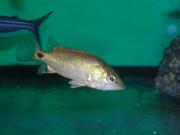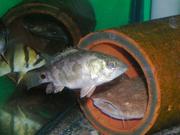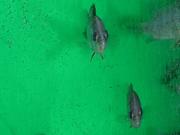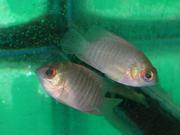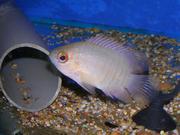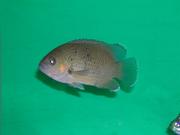Article categories:
Select a category below to view articles on each subject.
Search
Enter your keyword/s below to search :

Fish delivered straight to your door from Wildwoods
Hundreds of Species available today…
TFF Mailing List
Join the TFF mailing list today and we will email you with latest offers, news items and more.
Leaf fish: Challenging predators for the experienced aquarist
Leaf fish are predatory fish that have the shape and mottled brown colour of rotting leaves. In the wild they rely on this camouflage to stay hidden from their prey, which is invariably captured by stealth rather than speed. Most leaf fish have very large mouths, and when they open their mouths, the suction produced allows them to suck in whatever prey they were stalking.
Because they lack bright colours and prefer to stay hidden among floating plants, leaf fish don’t appeal to everyone. But to the aquarist with a taste for the unusual, they do have a certain charm all their own. Given their small size and lack of activity, most species work perfectly well in fairly modest aquaria, and while predatory, they aren’t aggressive, so can usually be kept in groups without problems. If you can provide them with the food they need, leaf fish can be very rewarding and worthwhile pets.
Taxonomy
There’s no single leaf fish genus or even family; the leaf fish body plan has evolved multiple times and the species traded come from South America, Africa, and Southeast Asia. Features common to the group include a strongly compressed body shape; a large mouth; large eyes; and a mottled brown colouration that breaks
There are two South American leaf fish species, Monocirrhus polyacanthus and Polycentrus schomburgkii, the two species comprising the entire family Polycentridae. Of the two, Monocirrhus polyacanthus is perhaps the more often seen in aquarium shops, but neither is widely traded or kept.
The family Nandidae is distributed across Africa and Southeast Asia, but the species from this family that are traded are generally only the Asian species. Historically it was species of Nandus that were most often seen, but in recent years Pristolepis species have become much more available.
Without a doubt the most commonly traded leaf fish isn’t really a leaf fish at all, but a climbing perch! This is the so-called African leaf fish Ctenopoma acutirostre, a member of the African and Asian climbing perch family Anabantidae. As such, it’s more closely related to the gouramis and bettas than any of the leaf fish mentioned so far.
Feeding
On the whole, leaf fish are hardy and easy to keep provided their feeding habits can be accommodated. There are considerable differences between the species though, with the Ctenopoma and Pristolepis being relatively easily satisfied with non-live foods, whereas Monocirrhus, Nandus, and Polycentrus tend to be much more picky.
Leaf fish of the genus Pristolepis are exceptional among leaf fish in being truly omnivorous: wild fish not only consume small animals but also a certain amount of plant material as well. Unsurprisingly, they’re quick to take almost anything, from earthworms and frozen bloodworms through to pellets and flake. In terms of plant material, algae-based flake food would probably suffice, but feel free to experiment with things like cooked peas, and the softer aquarium plants such as Indian fern (Ceratopteris spp.) will probably be nibbled on should these fish feel the need.
Ctenopoma aren’t interested in pellet or flake foods, but they take wet frozen foods very readily. Bloodworms, mosquito larvae and glassworms, whether live or frozen, are particularly welcomed, but otherwise small pieces of prawn, cockle and white fish go down well.
Monocirrhus, Nandus, and Polycentrus generally do not recognise frozen foods as being edible, and live foods will be required, at least to begin with. Small fish will take things like live mosquito larvae and bloodworms without much fuss, but larger fish will need meatier fare.
Earthworms and river shrimps are perhaps the ideal foods, being relatively easy to obtain and quite nutritious. River shrimps may contain a lot of thiaminase though, so should be used sparingly rather than as a staple. Thiaminase breaks down Vitamin B1, and in the process causes long-term health issues. Earthworms are very nutritious and fish do very well on them, but they’re only as safe as the places where they’re collected, so it’s important not to get earthworms from places where pesticides and other potentially toxic chemicals have been used.
The use of live feeder fish is contentious. Some species, notably minnows and goldfish, contain so much fat and thiaminase that their use simply cannot be recommended. Even as a treat, inexpensively reared “feeder fish” are likely to have received poor healthcare, and this reduces their value to little more than parasite time-bombs.
But if you’re prepared to breed your own feeder fish at home, and then gut-load them with a nutritious flake or pellet food before use, feeder fish can be safe and healthy. Livebearers are probably the ideal group because they’re easy to breed and nutritionally balanced; month-old molly fry for example would be a good size for most adult leaf fish species. Cichlids, on the other hand, may be easy to breed but they can be risky because of their spiny fins, so are best avoided.
There’s no reason you have to use live feeder fish for any leaf fish, but it cannot be ignored that the maintenance of many species, in particular Monocirrhus and Polycentrus species, is a good deal easier if you have a steady supply of small live fish.
The ethical dimension can’t be ignored though, so if you do decide to use feeder fish, it has to be because you need to, and not simply because you enjoy watching one fish eating another. Whatever thrill that might deliver, it’s worth mentioning that many leaf fish can live for ten or more years, and adults can consume a lot of food. Providing the equivalent of a female guppy or two per day for ten years or more quickly becomes a chore, but that’s pretty much what’s entailed when keeping the more finicky leaf fish is considered.
Aquarium maintenance
Apart from their need for live foods, leaf fish are generally very easy to keep. Water chemistry is of no great importance, though some may well prefer soft water given the choice. For the most part though, the usual pH 6-8, 5-20 degrees dH range works just fine. A few leaf fish also occur in brackish water, including Polycentrus schomburgkii and Nandus nandus, but they don’t need brackish water and do perfectly well in freshwater aquaria.
More of an issue is the overall tone of the aquarium. Leaf fish are mostly retiring fish, and with the exception of the quite active Pristolepis species, they do prefer to hide in shady corners for most of the time. Floating plants are the absolute ideal, particularly the big, leafy things like Ceratopteris ferns as well as those with long, trailing roots, such as Amazon frogbit. These will produce lots of shade without taking up too much space at the bottom, leaving room for hollow ornaments, rocky caves and bogwood roots.
Tankmates should be chosen with care. For obvious reasons, substantially smaller fish aren’t an option unless they’re being used as live food! But on the other hand, leaf fish don’t do well with hyperactive, nippy, or aggressive tankmates either. It’s perhaps best to keep them on their own, particularly in the case of those species that are difficult to feed, but otherwise bottom-feeding catfish, particularly loricariids, are the ideal tankmates. Other good choices might include slow predators such as spiny eels, bichirs, and freshwater sleeper gobies of appropriate size.
African Leaf fish, Ctenopoma acutirostre
Easily the best leaf fish for the beginner, this species is widely sold, hardy, peaceful, and easy to feed. It’s also rather an attractive fish, particularly when young, with a leopard-like pattern of spots across its body. It’s large eyes reveal its preference for dark, shady tanks, but otherwise it isn’t a fussy fish and can be slotted into peaceful community tanks without too much bother. Maximum size is about 20 cm (8 inches) but they are usually a little smaller than that. Given good conditions they are very long lived, the record being over 20 years!
One notable thing about Ctenopoma acutirostre is the way it reacts to aquarium size. In small tanks (130 litres/30 gallons or less) they are shy and even a bit nervous, but given adequate space, they’re much more outgoing. Juveniles are gregarious but adults are mildly territorial though rarely aggressive, territory holders usually doing nothing more serious than using their snouts to push rival fish away. In a reasonably big aquarium it is therefore perfectly possible to keep multiple specimens together, preferably allowing at least 60 litres per specimen.
Feeding is generally unproblematic as they readily take frozen foods as well as things like earthworms and mealworms. Very small fish will obviously be viewed as food, but otherwise they are excellent community fish ideally suited to use in African-themed community tanks alongside dwarf Synodontis, bichirs, Congo tetras and mormyrids.
Less commonly seen relatives with the same leaf fish morphology are Ctenopoma ocellatum and Ctenopoma weeksii. They are both a bit smaller, getting to about 12 cm (5 inches) or so in length, and have different, somewhat less striking, colouration. They can be kept in the same way as Ctenopoma acutirostre.
Pristolepis leaf fish
At least three species are now seen in the better aquarium shops, Pristolepis fasciatus, Pristolepis grootii and Pristolepis marginata.
All three get to about 15 cm (6 inches) in size and because they can all adjust their colours somewhat with mood and environment, telling them apart can be difficult. Pristolepis fasciatus tends to display a series of vertical bands on its flanks, whereas Pristolepis marginata has thin black and broad white bands along the edges of its unpaired fins. Pristolepis grootii is very similar to Pristolepis fasciatus, but tends to be more pinkish in colour compared to the predominantly green shades preferred by Pristolepis fasciatus.
These are active fish, and unlike the other leaf fish mentioned here, they are boisterous and need tanks with plenty of space and a good strong current. They are somewhat aggressive when sexually mature, so tankmates should be chosen that are sufficiently fast or phlegmatic that they won’t be bothered by these fish. Loaches, spanner barbs, catfish and some of the larger gouramis would all make good companions.
As discussed earlier, Pristolepis leaf fish are adaptable in terms of diet.
Asian Leaf fish, Nandus spp.
The precise number of Nandus leaf fish is open to debate, with several new varieties having recently appeared in the traded including Nandus “Slaty Blue” and Nandus “Brick Red”. As these trade names suggest, the differences between them are based on colour, and whether these turn out to be true species or simply geographical variants of existing species remains to be seen. In the case of Nandus “Slaty Blue”, this species was recently (2008) recognised as a distinct species, technically known as Nandus andrewi.
In any case, all Nandus species seem to be very similar in terms of size, behaviour and care. The biggest species is Nandus nandus, which gets to about 20 cm (8 inches) in length but most of the other species are much smaller, Nandus “Slaty Blue” for example getting to about 12 cm (5 inches). They are essentially loners in the wild and may exhibit a certain degree of territoriality when kept together, though juveniles are tolerant of one another, even gregarious.
Feeding can be a problem with Nandus species leaf fish because they are much less adaptable than any of the species discussed so far. They hunt entirely by sight, and movement in particular is required to get them to ‘strike’ at their prey. Live fish are preferred, but they readily take river shrimps and earthworms too, and smaller specimens will also accept aquatic insect larvae of all types.
Nandus are somewhat nocturnal, and do best when kept in shady tanks with lots of hiding places. Hollow ornaments such as pipes are favourite hiding places.
South American Leaf fish
Neither of the two South American leaf fish species Monocirrhus polyacanthus and Polycentrus schomburgkii are widely traded, in part because they have a reputation for being very difficult to maintain.
Of the two, Monocirrhus polyacanthus is the more often seen and perhaps the most desirable, being the leaf fish that takes its leaf-like camouflage to the highest degree. It has almost a perfectly leaf-shaped body as well as a single barbel on its snout that resembles the stalk of a leaf. It swims almost imperceptibly, in part thanks to its transparent fins, and instead seems to drift about, even rolling onto its side, just like a dead leaf might. When suitable prey comes into range, it opens its incredibly large tubular mouth and sucks in its target.
Monocirrhus polyacanthus is very definitely a fish for the single-species aquarium. It is so slow at feeding time that any sort of competition will cause problems, and it’s a sitting target for nippy or territorial tankmates. Adult Corydoras might be an option, as would Ancistrus catfish, but that’s about it.
Monocirrhus polyacanthus gets to a maximum length of about 10 cm (8 inches) and requires a reasonably large aquarium with a gentle current, lots of plants, and a dark substrate. Soft, slightly acidic water is preferred. They are notoriously fussy about food, and live foods of whatever type will be absolutely essential; only rarely are these fish completely weaned onto frozen foods, and they simply refuse dried or flake foods.
Polycentrus schomburgkii is very rarely seen. It gets to about 10 cm (8 inches) in length and has a more robust build than Monocirrhus polyacanthus. It is less fussy about water chemistry and also more accommodating in terms of diet, and in general terms can be kept much like the Asian Nandus species.
Other fish articles:
Other fish articles you may be interested in are listed below, click an article for full details.
-
FISH ARTICLE
-
FISH ARTICLE
-
FISH ARTICLE
-
FISH ARTICLE






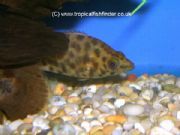
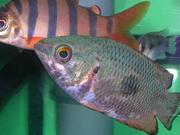
.jpg)
